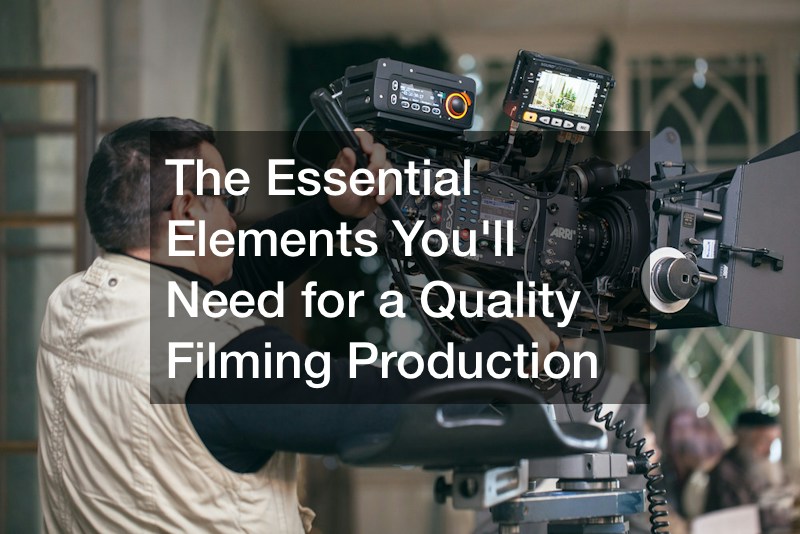When it comes to pulling off a great filming production, several key elements must fall perfectly into place. You’ll need top-notch equipment, a passionate crew, and a clear vision, to name just a few. But that’s just scratching the surface. Dive into this guide and discover the essentials for transforming good work into fantastic production. Let’s unlock the secrets behind making your footage come alive.
Have Adaptive Lighting

When you’re in the thick of the action, adaptive lighting can make a world of difference. It’s more than just parking lot lighting installation or adjusting the brightness on your camera. It’s about understanding how light can dramatically change the mood and create a unique atmosphere within your filming production. Good lighting can highlight the expressions of your actors, bring your scenes to life, and even invoke a sense of realism that’s hard to replicate.
Let’s face it; you can’t always rely on natural light, especially when shooting scenes at night or in gloomy weather. That’s when adaptive lighting comes into play. With the right mix of intensity, color temperature, and direction, you can create a visually stunning masterpiece. Don’t just settle for what’s available. Make adaptive lighting work for you.
Adaptive lighting isn’t static. It’s about being flexible, making changes on the fly, and always aiming for the best shot. In a way, it’s like conducting a symphony; you’re the maestro, and the lights are your orchestra. With the right tempo and rhythm, you can set the stage for a truly unforgettable production. Take charge, experiment, and find the perfect balance. Great lighting is essential to making your vision come to life.
Create Multifunctional Props
Creating multifunctional props is a vital aspect of a successful filming production. They can be repurposed and reused, providing a cost-effective solution for your budget. Imagine a simple piece of fencing material. In one scene, it’s just a fence. In another, it’s a barrier between two characters in a heated argument, adding symbolism and depth to your storytelling.
The key is to be creative and think outside the box. You’d be surprised how your prop can transform with different camera angles, lighting, and contexts. That piece of material could be a makeshift ladder in a chase scene or even an impromptu weapon in a suspense sequence. It’s all about how you frame and highlight it.
Don’t overlook the potential of multifunctional props in your production. They can enhance the visual storytelling, create intrigue, and contribute to the overall aesthetics of your scenes. Sometimes, the smallest details can make the biggest impact. Be resourceful, be daring, and let your props tell a story of their own.
Hire an Animal Handler
If your filming production includes animals, it’s crucial to hire a professional animal handler, especially when dealing with unpredictable creatures. An experienced handler ensures the safety and well-being of the animals involved whilst also helping to facilitate smooth and efficient shooting. They’re trained to understand animal behaviors, which can significantly enhance the authenticity of your scenes.
Incorporating other wildlife into your production can add an exciting dynamic, but it also presents unique challenges. Squirrels, although cute, can be challenging to work with due to their fast and unpredictable nature. An animal handler’s expertise helps mitigate these complications, ensuring that they perform as required and contribute positively to the overall production of the film.
It’s essential to remember that quality always trumps quantity in a successful production. Cutting corners by not hiring a professional handler can lead to unnecessary setbacks and even potential legal issues. It’s about respecting all cast members, humans, and animals alike, and ensuring everyone’s safety and comfort on set.
Utilize 3D Printing

Incorporating 3D printing into your filming production can revolutionize the way you approach set design and prop creation. It’s a versatile tool that can recreate intricate and unique pieces with precision. From creating detailed architectural models to reproducing antique artifacts, 3D printing brings your vision to life and adds a touch of realism to your scenes.
One innovative way to use 3D printing in your production is through the creation of customized ice cubes. The end product can be designed to fit your movie’s theme or to add an element of surprise to a particular scene. Imagine a drink in a scene with these customized ice-shaped mini film reels or a character’s face, offering a subtle yet impactful visual detail.
The integration of 3D printing into film production isn’t just about creativity; it’s about cost efficiency as well. With 3D printing, you’re able to produce several props at a fraction of the cost, reducing your production budget. It lets you experiment freely with your visual storytelling without being constrained by financial resources.
Build Modular Set Components
Building modular set components is an inventive strategy that can simplify the logistics involved in filming production. At its core, this approach involves using versatile building supplies to create segments of a set that can be easily assembled, disassembled and rearranged. It’s a game-changer, especially when you’re dealing with a complex set or have scenes that require quick transitions.
The brilliance of modular set components is evident in their adaptability. You’re not locked into a specific design or layout — each portion of the set can be modified or moved to suit the scene’s needs. It’s all about crafting a dynamic environment that can evolve along with your story. Plus, storage is a breeze. When not in use, you can conveniently disassemble and store the components, freeing up valuable space on the production floor.
Let’s not forget about the financial advantages. Incorporating modular set components into your production can lead to significant cost savings over time. By reusing and rearranging the same elements, you’re reducing the need for new supplies with every scene change. It’s a strategy that beautifully marries creativity, practicality, and cost-efficiency in the world of film production.
Use Wireless Control Systems
Wireless control systems are revolutionizing the world of filming production. They offer an unrivaled level of flexibility and convenience that traditional wired systems just can’t match. By eliminating the need for physical connections, these systems reduce clutter and the risk of tripping hazards on set. They’re easy to set up and less likely to require an electrical contractor, which can be both cost and time-saving.
These systems can be controlled remotely, giving you the ability to quickly and seamlessly adjust light levels, sound, and other technical aspects of your production. Whether you’re positioned behind the camera or in the control room, you can orchestrate the perfect scene with just the touch of a button. It’s like having a magical remote control that can adjust almost any aspect of your film production, all without you needing to physically touch the equipment.
There’s also the added bonus of scalability. Wireless control systems can be easily expanded or minimized to suit the specific needs of your production. You’re not bound by the constraints of wires or the availability of power outlets, so you can add or remove devices at will.
Experiment With Shadows

Shadows can be powerful additions to your filming production. They have the ability to alter the mood, create depth, and add an element of mystery to your scenes. Whether they’re soft and subtle or dark and dramatic, shadows can evoke a wide range of emotions, making your film more compelling and visually appealing.
Learning how to experiment with shadows can significantly enhance your filming expertise. It’s about understanding the relationship between light, objects, and their resulting shadows. By adjusting the angles or intensity of your lighting, you can play with shadow lengths and sharpness, creating interesting visual effects that captivate your audience.
However, the use of shadows shouldn’t be an afterthought. It’s essential to plan their incorporation into your scenes during the pre-production phase. By doing so, you’ll ensure that shadows complement your story rather than detract from it. In film production, lighting and shadows are not just technical aspects; they’re tools for storytelling.
Invest in Security
When it comes to filming production, the importance of security can’t be overstated. Protecting your equipment, set, and crew is a vital aspect of a successful shoot. One essential step to safeguard your on-set resources is the use of secure door locks. These locks act as the first line of defense against unwanted intrusions, keeping your valuable filming gear and property safe from theft or damage.
The peace of mind that comes with a well-secured production set can immensely boost the morale and productivity of your crew. It’s not just about the physical security of the set but also about creating an environment where everyone can focus on their individual roles without any undue concerns. Surveillance systems and access controls are all components contributing to this secure and conducive atmosphere.
Remember that investing in security doesn’t mean you have to break the bank. There are a variety of security systems available in the market that cater to different budget ranges. The key is to understand your specific needs in production and choose a solution that offers the best balance between cost and security.
Ensure Safety on the Set
While focusing on the creative aspects of filming production, it’s crucial not to overlook the matter of on-set safety. Accidents can happen at any time, and it’s not just the expensive equipment that’s at risk; the people on set are, indeed, your most valuable assets. A safe working environment does more than just prevent accidents; it fosters a more productive, positive atmosphere. A personal injury attorney can confirm that a safe set can prevent costly lawsuits and protect your team from harm.
To ensure safety, start by creating a comprehensive safety plan that covers everything from equipment handling to emergency procedures. Training your crew about safety rules isn’t just a good idea; it’s a necessity. Everyone on the set, from the director to the intern, plays a role in ensuring a safe environment. Your safety plan will serve as a guideline, a way to instill a mindset of safety first in all your team members.
Be proactive, not reactive. Regularly inspect your equipment and set, and take care of maintenance issues right away. Ensure that your crew has easy access to first aid kits and that everyone knows their location. Your safety measures should be as much a part of your production as your creative process.
Consider Practical Effects

The use of practical effects in filming production has seen a resurgence in recent years. Directors and producers are recognizing the tangible benefits that come from incorporating real-world elements into their scenes. Instead of relying entirely on computer-generated imagery (CGI), they’re turning to practical effects for a more authentic, believable visualization. This shift doesn’t mean CGI is obsolete; rather, it highlights the importance of balancing between digital creativity and physical realism.
One of the more technical aspects of practical effects includes the incorporation of fire rated glass. It’s a specialty product designed to withstand intense heat and prevent the spread of fire. Using fire rated glasses in film production can provide a genuine spectacle while maintaining a safe environment on set. It adds a level of realism that can’t be achieved with digital fire effects, thus boosting the overall cinematic experience for the audience.
Despite its advantages, practical effects can introduce additional safety considerations on the set. Producers must ensure that safety protocols are strictly adhered to when using materials like the one mentioned above. The film crew should be properly trained in handling such materials, and emergency procedures should be in place.
In the world of film production, achieving fantastic results involves mastering key elements. Adaptive lighting brings scenes to life, while versatile props add depth to storytelling. Incorporating 3D printing for creativity and cost efficiency, using modular set components for flexibility, and embracing wireless control systems transform the production process. Experimenting with shadows, prioritizing security, and ensuring on-set safety enhance quality and protect assets. Practical effects strike a balance between digital creativity and physical realism, elevating the cinematic experience. Mastering these essentials helps your vision come alive and sets your work apart in the ever-evolving landscape of film production.





